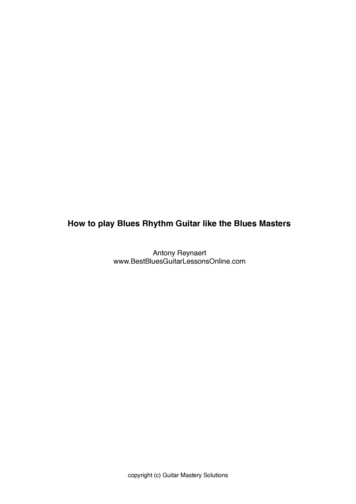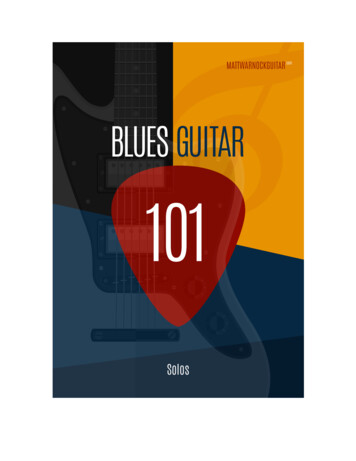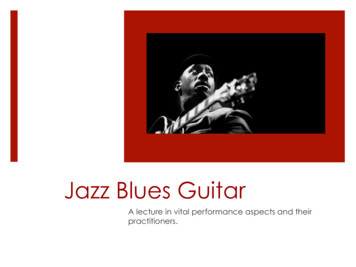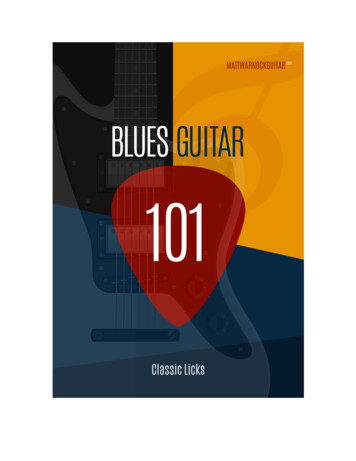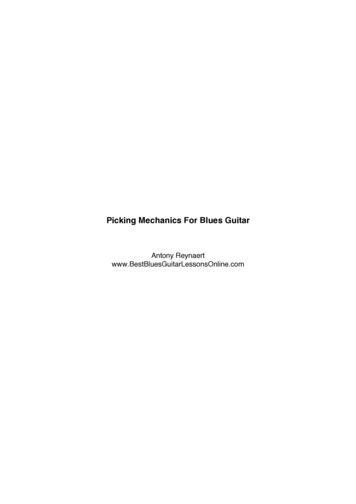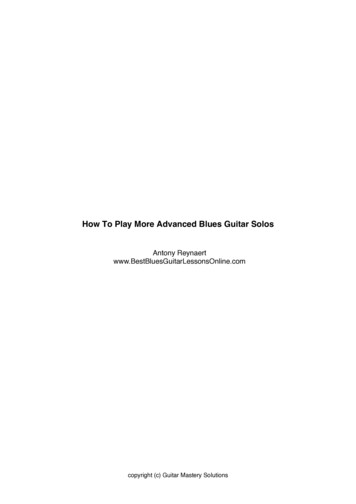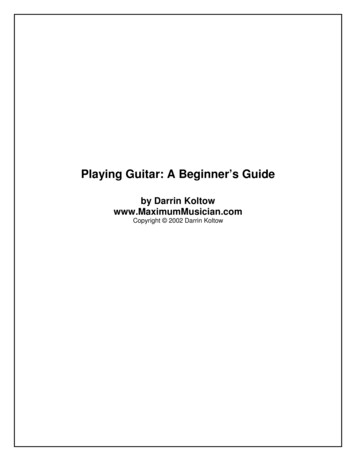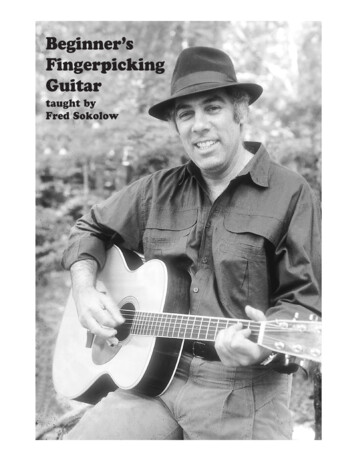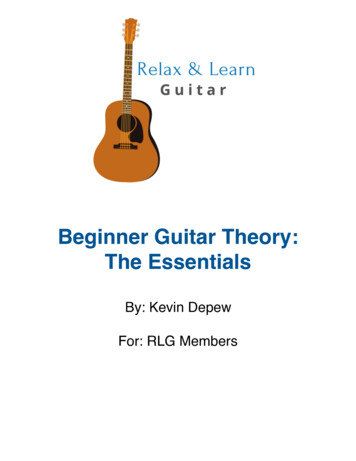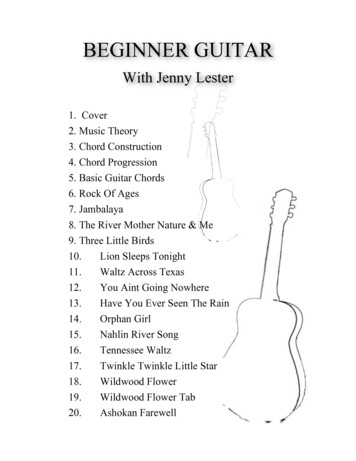
Transcription
NEXT LEVEL GUITAR BEGINNER BLUES LICKS & JAMMINGGUITAR WRITTEN LESSON MANUAL-written by David Taub
Written LessonPageTable of contents . 2Introduction . 3DVDs lesson menu contents . 4Getting started . 5Notes on the fretboard . 6Scales defined and drawn out . 7The Minor Pentatonic scale . 8String bending with the Minor Pentatonic Scale . 9The Minor Pentatonic Expanded I Scale . 10The Minor Pentatonic scale five box positions – boxes 1 & 2 . 11The Minor Pentatonic scale five box positions – boxes 3, 4, & 5 . 12The Minor Pentatonic Expanded II Scale . 13The Blues scale . 14The Blues Expanded II Scale . 15Minor Pentatonic uses study guide illustration . 16Spicing up Minor Pentatonic & Blues Scales . 17-18The Major Pentatonic scale . 19-20The Natural Minor Scale . 21-22Key Signature and chord analyzing . 23The choices when soloing . 24Soloing choices study guide illustration . 25Minor & major key soloing application . 26Lead playing application for jam tracks . 27Delta/Chicago Blues Jam Tracks CD – track by track . 28-35Blues Jam Tracks CD – track by track . 36-43Rock Jam Tracks CD – track by track . 44-49Lead Playing – Tone . 50Lead Playing – rhythm, the ride, note choice, & phrasing . 51Musical template examples 1 . 52Musical template examples 2 . 53Musical template examples 3 . 54Minor key solo theory . 55Minor key musical template examples . 56-58Soloing techniques review . 59Finger Exercises . 60Top ten tips to get your playing to the next level . 61-62Chord construction . 63-64Building chords from the Major scale . 65The Circle of 5ths . 66Blank tablature staff paper (document your favorite licks & riffs) . 67-69Blank chord boxes to notate chord diagrams . 70-71TABLEOFCONTENTS-Written by David Taub, co-creator, Next Level Guitar Inc. Copyright Next Level Guitar Inc., 2014 - all rights reserved – unauthorized duplication or distribution of any part of this book is prohibited2
INTRODUCTION:Hello good people! David Taub here, and I want to thank you for purchasing this instructional product.This Ebook was designed to coincide with the Beginner Blues Licks & Jamming DVD course. But thisbook can also be used on its own as a stand alone reference guide to scale diagrams, lead guitarsoloing strategies, learning to play over chord changes, and more.This NLG Beginner Blues Licks & Jamming DVD course comes complete with five DVDs and threeaudio jam track CDs. These instructional DVDs, audio CDs, and this Ebook is an excellent tool for theguitarist to develop and enhance their lead guitar playing, improvisation skills, music theory knowledge,scales and learning, fretboard knowledge, and much more.Remember that the points I list throughout these materials are guidelines to get you started - notnecessarily rules forged in stone. Often in jams you have to use your discretion. Creativity is key andlistening and learning how certain notes, scales, or arpeggios work over certain chords or progressionswill continue to move your playing forward.We will start out with learning some Pentatonic Scales, and then learning the notes on the neck so youcan find these scales anywhere on the guitar in any key. Chip away at learning the notes a little eachday as part of you practice routine. Then we get into some simple licks and how you can start taking thenotes of the scale and do interesting things with them and create music. We start off simple and buildfrom there as you go through the DVD lessons.Throughout the DVD lessons we teach you not just licks, but how to “learn from the lick” – what scale isthe lick from, how it is used, how to turn one lick into ten licks using variation. So remember to learnfrom the lick and soon you will have an endless array of licks in your guitar arsenal.We then demonstrate the licks and phrases over the included jam tracks. Utilizing the jam tracks is anessential practice tool that will help you not only get to know the licks, but also how to phrase them anduse them in real musical situations. The included jam tracks are in a variety of keys, so you canpractice the licks that you learn from the DVDs in not just one key, but any key. Take advantage of thetracks and use them to their fullest, they are an invaluable tool for the practicing guitarist.Keep accurate records in your practice log of the items you are working on, what needs work, chordchanges, progressions, songs, original material, scales, etc. Date the entries and keep track of yourprogress as you move forward in your guitar journey. Just like setting goals in life you want to setmusical goals and then go out there and achieve them.Don’t overwhelm yourself by trying to take on too many new things at once. Take these lessons andtechniques in stages, slow and steady wins the race. One of the keys is consistency. Put those guitarsin your hands every day, even if it’s only for ten or fifteen minutes. You don’t necessarily need an hourblock of time each day to learn guitar. Those little pockets of time where you can practice for just tenminutes or so really add up.Enjoy these materials and please let me know if you have any questions. I always welcome yourinsights and feedback as I am constantly tweaking my instructional products to make them the bestthey can be. You can email me at thenextlevelguitar@yahoo.comStay positive and remember that your guitar playing is an evolution.And please check out my full-on video instructional website at www.nextlevelguitar.comI wish you the best in all your musical endeavors.Thanks again, enjoy the journey, and as always .ROCK ON!David Taubwww.nextlevelguitar.comCopyright Next Level Guitar Inc., 2014 - all rights reserved – unauthorized duplication or distribution of any part of this book is prohibited3
BEGINNER BLUES LICKS & PHRASING DVDS LESSON MENU CONTENTS:This DVD set contains five DVDs and three Audio Jam Track CDs. Below is a listing of eachdisc and its menu.Insert the DVD into your player and the main menu screen appears. On the main menu screenmusic is playing and pictures are scrolling. On the left of the main menu screen written in whitetext are main menu items. To navigate through the DVD menus move the cursor to the left ofany menu item to get the red dot to appear. Then click on the red dot to get to the submenuscreen. At the submenu screen repeat the process of clicking on the red dot just to the left ofany lesson title written in white text. This will take you to the lesson. Keep repeating throughoutall the DVDs – same protocol for all DVDs – enjoy!LESSON MENUS ON EACH DVD:DVD 1 – DVD Introduction-Scale Positions-Learn Notes-EZ Fun Licks-Essential Licks-Build DexterityDVD 2 – Octave Licks-Build Phrases-Lick Vocabulary-Mix Major and MinorDVD 3 – Passing Tone Licks-More Licks-Doublestop Licks-Add Spice to your Licks-Move Pentatonic PositionsDVD 4 – Target Note Licks-Flashy Licks-Jam & Apply I-Jam & Apply IIDVD 5 – Rhythm & Licks-Jam & Apply III-Bonus Lessons-Bonus FootageJAM TRACK AUDIO CDs:1. Delta/Chicago Blues Jam Tracks Audio CD2. Blues Jam Tracks Audio CD3. Rock Jam Tracks Audio CD4
GETTING STARTED:Throughout this Ebook I discuss many different guitar avenues to try when soloing andimprovising. I suggest starting with the Pentatonic Scales from the DVD lessons and buildingfrom there. Don’t overwhelm or put any undue pressure on yourself. Work on the basics firstand then build from there as you move through your guitar journey. You don’t have to masterone lesson or concept before moving to the next. Your practice routine should include a fewdifferent paths that you are working on simultaneously.It’s vital to learn about the “why” things work. It will give you the lead guitar confidence to beable to instantly know what avenues are possible when soloing and improvising. Then you willhave the tools to blast these lead playing techniques across all your playing at any given time,in any given jam, and in any given song.Remember, even though you may work tirelessly on lead guitar, you want to keep practicingand working on your rhythm skills. Rhythm and timing are critical elements to overall abilitieson the guitar. Never forget that lead playing will really only ever be as good as your rhythmplaying.Soon you will be letting your ear take you to all the right notes and chords. You won’t have tothink about techniques and application but rather you will focus on the emotion and feeling inyour playing. The more you practice and apply these materials the faster you will be on“autopilot”.At first you will be utilizing pentatonic scales over these blues and rock jams. Down the road, Isuggest trying to learn additional lead guitar avenues that I mention throughout this manual.But all in time, start simple and build over time – don’t overwhelm yourself and don’t get tooabsorbed in the theory aspect at this point in your guitar journey. A little theory is okay for now,but you want to spend more time playing and applying what you are learning to the jam tracks.The theory will come.I do include some theory in this manual, but at first you can skim over it and you can revisit thetheory later once you get more comfortable jamming using Pentatonics over the tracks.KEY POINT: At this stage of your lead guitar journey, there is no substitutefor practicing the right things, learning scales, studying the sounds andrelationships between chords and scales, developing your ear, practicingand honing your skills using jam tracks, and continually pushing yourselfand refining your art.Copyright Next Level Guitar Inc., 2014 - all rights reserved – unauthorized duplication or distribution of any part of this book is prohibited5
NOTES ON THE BEG#C#DGCFADEdie Ate Dynamite Good Bye Edie# SHARPb FLAT1st Fret3rd fret5th fret7th fret9th fretE and D stringsare related – fromany note on the Estring go 2 stringsdown and 2 fretsover and you havethe same note anoctave higher onthe D stringEbG#C#F#BbEbEADGBE12th fretThe twelve-note scale consists of:A, Bb, B, C, C#, D, Eb, E, F, F#, G, G#Copyright Next Level Guitar Inc., 2014All rights reserved – unauthorized duplication or distribution is prohibitedLow E and High Estrings have samenote names on eachfret – just twooctaves apartA and G strings are related –from any note on the A stringgo 2 strings down and 2 fretsover and you have the samenote an octave higher on theG string6
SCALES DEFINED:Understanding and learning scales is a critical element in your guitar journey. Scales are thebuilding blocks to creating licks and the roadmap to the fretboard. At first you want toconcentrate on the scales that we teach and utilize throughout the DVD lessons – the Minorand Major Pentatonic Scale and the Blues Scale.Pentatonic Scales are the most common scales used in most genres of music. So they are agreat place to start – especially for Blues and Rock music.Scales are a group or collection of notes in ascending or descending order that we use inmusic. Scale notes are listed out in order and usually sound from low to high.The order of the notes used in a scale is crucial, as that order provides a measure of musicaldistance. The distance between notes is called an interval. How scale notes line up, or theintervals, will give the scale not only its name but also its mood or musical flavor. Just likecertain chords have a mood to them, scales also evoke certain moods.One critical aspect of a scale is its root note. The root note is the starting note and note whichall the other scale notes gravitate toward. I like to call the root note “home base”. Most othernotes seem to want to resolve to it and it’s the tonic center for the scale. Many times I knowinstantly the key of a given song or progression by just listening for what sounds like homebase. What are all the chords or notes pulling toward? The root is very
NEXT LEVEL GUITAR BEGINNER BLUES LICKS & JAMMING . BEGINNER BLUES LICKS & PHRASING DVDS LESSON MENU CONTENTS: This DVD set contains five DVDs and three Audio Jam Track CDs. Below is a listing of each disc and its menu. Insert the DVD into your player and the main menu screen appears. On the main menu screen music is playing and pictures are scrolling. On the File Size: 1013KBPage Count: 71
